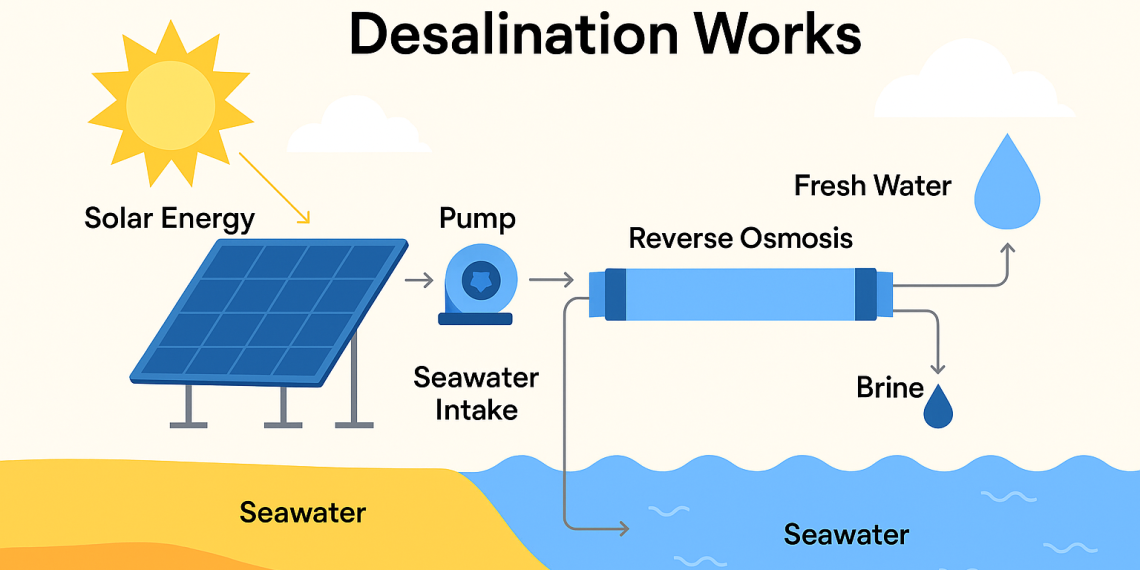Water scarcity continues to affect billions globally, especially in coastal and arid regions. In these areas, seawater is abundant but undrinkable without treatment. Enter solar-powered desalination machines — an innovative, eco-friendly solution that uses the power of the sun to turn seawater into clean, potable water.
In this guide, we’ll break down how these systems work, what makes them so efficient, and why they are becoming the preferred choice for off-grid and remote applications.
What Is a Solar-Powered Desalination Machine?
A solar desalination machine is a system that removes salt and impurities from seawater using solar energy as its power source. Most modern solar desalination systems are built using reverse osmosis (RO) technology, powered by photovoltaic solar panels.
These units are ideal for areas lacking reliable grid electricity, including island communities, disaster zones, rural agricultural sites, and military deployments.
Key Components of a Solar RO Desalination System

AMPAC USA’s solar seawater desalination machines are a benchmark in the industry. Here’s what typically powers the process:
1. Photovoltaic Solar Panels
Solar panels generate DC electricity from sunlight, which powers pumps and controllers within the unit.
2. Pre-Treatment Filtration
Raw seawater passes through sediment filters to remove large particles and organic matter.
3. High-Pressure RO Membrane
The heart of the system, RO membranes filter out up to 99.9% of salts, bacteria, and heavy metals from seawater.
4. Post-Treatment
UV sterilizers or activated carbon filters enhance water quality and safety for drinking and other uses.
5. Smart Controllers
These adjust flow rates and optimize energy use based on available sunlight.
6. Brine Discharge Control
Wastewater is safely discharged or recycled using environmentally safe techniques.
Step-by-Step: How the Desalination Process Works
- Solar Power Generation: Sunlight hits the PV panels, creating power for the system.
- Water Intake: Seawater is pumped into the system.
- Filtration: Pre-filters remove particles and biological contaminants.
- Reverse Osmosis: Water is forced through membranes, separating clean water from brine.
- Post-Treatment: Final filtration polishes the water for taste and safety.
- Storage or Direct Supply: Freshwater is sent to a tank or distributed for immediate use.
Benefits of Using Solar RO Desalination Machines
- Off-Grid Ready: Operates independently of electricity grids or diesel generators
- Eco-Friendly: Reduces carbon emissions and energy costs by up to 90%
- Highly Portable: Ideal for military, disaster relief, or mobile medical units
- Customizable Capacities: Systems available from 2,500 to 15,000 GPD
- Minimal Maintenance: Automated operation with smart controllers
- Safe & Reliable: High water recovery and salt rejection rates
Common Applications
- Coastal villages and island communities
- Humanitarian relief camps
- Military field operations
- Offshore installations and ships
- Remote agricultural farms
- Disaster-hit zones with no power
Why Choose AMPAC USA for Solar Seawater Desalination?
With 30+ years of water treatment expertise, AMPAC USA designs and manufactures fully integrated solar-powered reverse osmosis systems for harsh environments. Each system is engineered for long-term durability, easy deployment, and maximum water recovery with minimal environmental impact.
Learn more about our full range of Solar Watermaker Systems
Final Thoughts
As climate change worsens global water scarcity, solar desalination emerges as a scalable, sustainable solution. Whether you’re looking to power a coastal facility or support a remote field camp, a solar RO machine ensures consistent, clean water — with zero fuel costs and minimal ecological impact.











